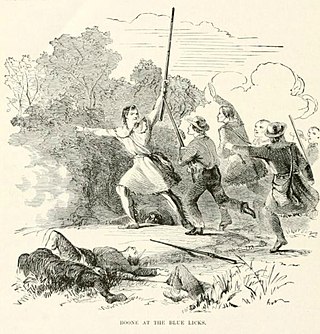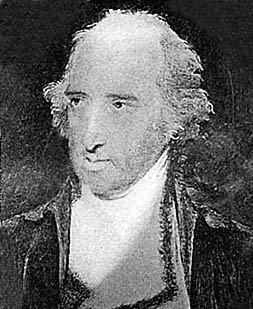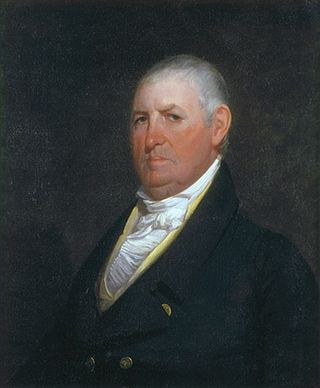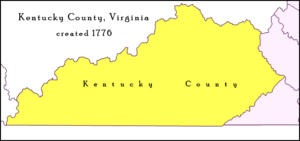
The Battle of Blue Licks, fought on August 19, 1782, was one of the last battles of the American Revolutionary War. The battle occurred ten months after Lord Cornwallis's surrender at Yorktown, which had effectively ended the war in the east. On a hill next to the Licking River in what is now Robertson County, Kentucky, a force of about 50 Loyalists along with 300 indigenous warriors ambushed and routed 182 Kentucky militiamen, who were partially led by Daniel Boone. It was the last victory for the Loyalists and natives during the frontier war. British, Loyalist and Native forces would engage in fighting with American forces once more the following month in Wheeling, West Virginia, during the Siege of Fort Henry.
Chalahgawtha was the name of one of the five divisions of the Shawnee, a Native American people, during the 18th century. It was also the name of the principal village of the division. The other four divisions were the Mekoche, Kispoko, Pekowi, and Hathawekela. Together these divisions formed the loose confederacy that was the Shawnee tribe.

The Illinois campaign, also known as Clark's Northwestern campaign, was a series of engagements during the American Revolutionary War in which a small force of Virginia militia led by George Rogers Clark seized control of several British posts in the Illinois Country of the Province of Quebec, located in modern-day Illinois and Indiana in the Midwestern United States. The campaign is the best-known action of the western theater of the war and the source of Clark's reputation as an early American military hero.

George Rogers Clark was an American military officer and surveyor from Virginia who became the highest-ranking Patriot military officer on the northwestern frontier during the Revolutionary War. He served as leader of the Virginia militia in Kentucky throughout much of the war. He is best known for his captures of Kaskaskia in 1778 and Vincennes in 1779 during the Illinois campaign, which greatly weakened British influence in the Northwest Territory and earned Clark the nickname of "Conqueror of the Old Northwest". The British ceded the entire Northwest Territory to the United States in the 1783 Treaty of Paris.

Henry Hamilton was an Anglo-Irish military officer and later government official of the British Empire. He served in North America as Lieutenant Governor of the Province of Quebec and later as Deputy Governor after the American Revolutionary War. He later served as Governor of Bermuda and lastly, as Governor of Dominica, where he died in office.

William Darke was an American soldier who served with British forces before the Revolutionary War. He served with British regulars commanded by Major General Edward Braddock in his 1755 expedition to the French-controlled Ohio Valley, as part of the French and Indian War. The British forces were defeated and Braddock died.

Isaac Shelby was the first and fifth Governor of Kentucky and served in the state legislatures of Virginia and North Carolina. He was also a soldier in Lord Dunmore's War, the American Revolutionary War, and the War of 1812. While governor, he led the Kentucky militia in the Battle of the Thames, an action that was rewarded with a Congressional Gold Medal. Counties in nine states, and several cities and military bases, have been named in his honor. His fondness for John Dickinson's "The Liberty Song" is believed to be the reason Kentucky adopted the state motto "United we stand, divided we fall".

The western theater of the American Revolutionary War (1775–1783) was the area of conflict west of the Appalachian Mountains, the region which became the Northwest Territory of the United States as well as what would become the states of Arkansas, Kentucky, Louisiana, Missouri, and Tennessee. The western war was fought between American Indians with their British allies in Detroit, and American settlers south and east of the Ohio River, and also the Spanish as allies of the latter.

Colchester is a community and unincorporated place in Southwestern Ontario, the southernmost settlement on mainland Canada, and the southernmost point with the exception of Point Pelee National Park. It is located on the north shore of Lake Erie, approximately 6 kilometres (3.7 mi) south of the town of Harrow. Colchester was formerly part of the Township of Colchester South and is now a part of the amalgamated Town of Essex within the County of Essex. Colchester shares its postal code with Harrow as N0R 1G0.

Bryan Station was an early fortified settlement in Lexington, Kentucky. It was located on present-day Bryan Station Road, about three miles (5 km) northeast of New Circle Road, on the southern bank of Elkhorn Creek near Briar Hill Road. The settlement was established in the spring of 1776 by brothers Morgan, James, William, and Joseph Bryan, and brother-in-law William Grant, all from Yadkin River Valley, Rowan County, North Carolina. After a disastrous winter and attacks by Native Americans, all the Bryan family survivors abandoned the station and returned to the Yadkin River Valley in August 1780. Falling under the command of Elijah Craig, the remaining occupants withstood several American Indian attacks.

During the 18th and early 19th centuries, the French, British and U.S. forces built and occupied a number of forts at Vincennes, Indiana. These outposts commanded a strategic position on the Wabash River. The names of the installations were changed by the various ruling parties, and the forts were considered strategic in the French and Indian War, the American Revolutionary War, the Northwest Indian War and the War of 1812. The last fort was abandoned in 1816.
Egushawa, also spelled Egouch-e-ouay, Agushaway, Agashawa, Gushgushagwa, Negushwa, and many other variants, was a war chief and principal political chief of the Ottawa tribe of North American Indians. His name is loosely translated as "The Gatherer" or "Brings Together". He was a prominent leader among the Detroit Ottawa, a prominent group in southeast Michigan and northwest Ohio. Egushawa is considered a successor to Chief Pontiac. As a leader in two wars against the United States, Egushawa was one of the most influential Native Americans of the Great Lakes region in the late eighteenth century.

The siege of Boonesborough was a military engagement which took place in September 1778 during the American Revolutionary War. On September 7, Shawnee chief Blackfish, who was allied to the British, led an attack on the Kentucky settlement of Boonesborough. Months before the battle, Blackfish had captured and adopted Daniel Boone, the founder of Boonesborough. Boone escaped the Shawnees in time to lead the defense of the settlement. Blackfish's siege was unsuccessful and was lifted after eleven days. Boone was then court-martialed by fellow officers who suspected him of harboring Loyalist sympathies. He was acquitted, but soon left the settlement.
Colonel Archibald Andrew Lochry was a colonial American military officer whose command ended in disaster when he and nearly every member of his force were killed or captured by Mohawk forces led by George Girty, the brother of Simon Girty, and Chief Joseph Brant. This skirmish is famously known in early American history as Lochry's Defeat.

Lochry's Defeat, also known as the Lochry massacre, was a battle fought on August 24, 1781, near present-day Aurora, Indiana, in the United States. The battle was part of the American Revolutionary War (1775–1783), which began as a conflict between Great Britain and the Thirteen Colonies before spreading to the western frontier, where American Indians entered the war as British allies. The battle was short and decisive: about one hundred Indians of local tribes led by Joseph Brant, a Mohawk military leader who was temporarily in the west, ambushed a similar number of Pennsylvania militiamen led by Archibald Lochry. Brant and his men killed or captured all of the Pennsylvanians without suffering any casualties.
Isaac Bowman was an 18th-century American soldier and militia officer who took part in the American Revolutionary War and the Northwest Indian War. His capture and eventual escape from hostile Chickasaw led him on a two-year adventure before returning to the United States from Cuba in 1782.
Captain Isaac Ruddell was an 18th-century American Virginia State Line officer during the American Revolutionary War and a Kentucky frontiersman. He was an officer commanding a company under BGEN George Rogers Clark (1777–1782). He was the founder of Ruddell's Station, or fort, on the Licking River in present-day Harrison County, Kentucky. In 1780, during the Revolutionary War, the settlement was destroyed by joint British Canadian and Eastern Woodlands Indian forces under British officer Captain Henry Bird. He and his family were held prisoner in Detroit for over two years before their release. Two of his sons were later taken captive by Shawnee, one of them becoming adopted brother of the famed warrior Tecumseh.

The Battle of Piqua, also known as the Battle of Peckowee, Battle of Pekowi, Battle of Peckuwe and the Battle of Pickaway, was a military engagement fought on August 8, 1780 at the Indian village of Piqua along the Mad River in western Ohio Country between the Kentucky County militia under General George Rogers Clark and Shawnee Indians under Chief Black Hoof. The Indians were driven off and the village and surrounding fields burned, but Clark suffered daunting casualties. Clark's expedition was in response to Bird's invasion of Kentucky earlier that summer by a combined force of Shawnee, Lenape and Miami warriors that killed and captured hundreds of white settlers.

During the War of 1812, the Indiana Territory was the scene of numerous engagements which occurred as part of the conflict's western theater. Prior to the war's outbreak in 1812, settlers from the United States had been gradually colonizing the region, which led to increased tensions with local Native Americans and the outbreak of Tecumseh's War. In 1811, Tecumseh's confederacy, formed in response to encroachment by white American settlers, was defeated by U.S. forces at the Battle of Tippecanoe. After the conflict broke out, most Native Americans in the region joined forces with the British Empire and attacked American forces and settlers in concert with their British allies.

The Westervelt massacre, also known as the Westerfield massacre, was an attack by Native Americans on a caravan of Dutch American settlers on June 27, 1780, near the frontier. Occurring amidst the backdrop of the Revolutionary War, the attack remains one of the largest massacres in the history of Kentucky.














